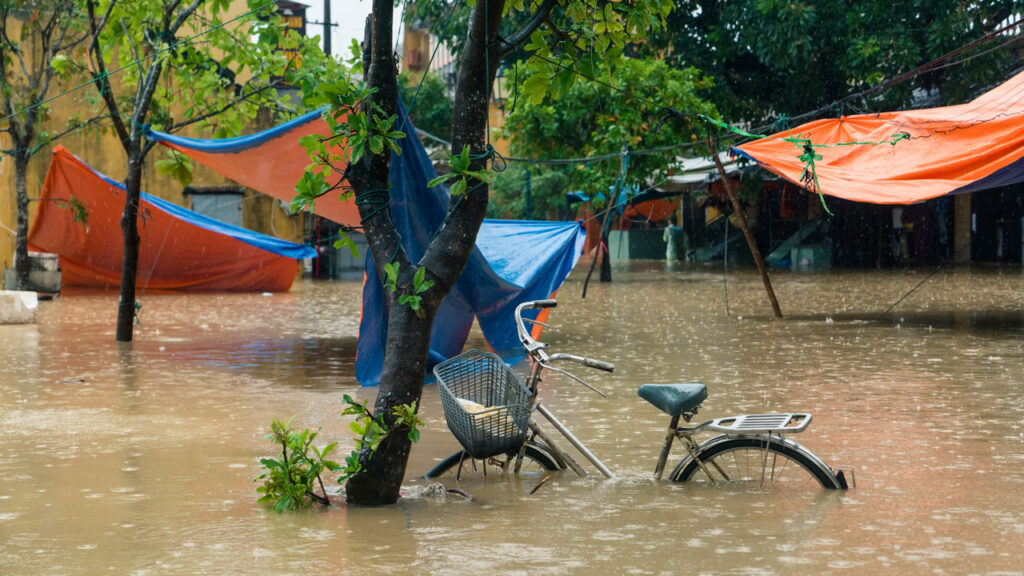
What are typhoons and is climate change making them worse?
Typhoon Yagi, Vietnam’s most powerful storm in 30 years, has brought heavy rainfall, strong winds, and flooding which have devastated the Philippines, South China and the north Vietnam.
We spoke to researchers at the National Centre for Atmospheric Science about typhoons, and the impact climate change may be having on this type of extreme weather.
What is a typhoon?
Typhoons, hurricanes, and tropical cyclones are all different names for the same type of tropical storm.
“Tropical cyclones are characterised by strong winds, heavy rains, and an ‘eye’ in the centre of a warm-core, low pressure rotating weather system,” explains Xiangbo Feng, climate researcher at the National Centre for Atmospheric Science and the University of Reading.
Whether a tropical cyclone is called a hurricane, typhoon or cyclone, depends on where in the world it develops. When a tropical cyclone develops over the Northwest Pacific Ocean and its winds reach speeds of 74 miles per hour, it is called a typhoon.
Typhoons typically affect the Philippines, Vietnam, China, South Korea and Japan.
How do typhoons form?
Typhoons start out at sea from small weather disturbances in the atmosphere before developing into large-scale tropical storms.
Dr Feng explains how typhoons form in more detail:
“Typhoons develop out at sea. Most of them form east of the Philippines and originate from synoptic-scale atmospheric disturbances. When propagating westward into the warm pool region due to the easterly steering flow, some systems grow into typhoons because of the warm ocean, high air moisture, and low vertical wind shear.
“Typhoons usually become weaker when approaching coastal regions and migrating north, with some further transformed to extra-tropical cyclones in the process known as extratropical transition. After making landfall, typhoons normally lose the cyclone feature, and are referred to as remnants. The remnant, an inland system, can still lead to heavy rain and flooding, for example the 2023 Beijing catastrophic floods caused by typhoon Doksuri.”
“This year, typhoon Yagi made it one of the most severe storms in the South China Sea on record. It is very rare to witness a super typhoon (category three and above) striking Vietnam because climatologically the ocean and atmosphere over there don’t hold enough energy to maintain a super strong storm (wind speed more than 111 miles per hour). We suspect that this unprecedented event is, at least partially, caused by climate change,” adds Dr Feng.
What impact does climate change have on typhoons?
Human-induced climate change is driving an increase in average global temperatures.
Warmer temperatures provide favourable conditions for typhoons to become more hazardous, as the higher humidity in warmer air, the warmer sea surface temperatures, and the changes in large-scale circulation, could lead to stronger storms.
“Warmer temperatures also make wider areas for typhoons to occur or maintain a high strength level, which has not been seen in historic records before, such as super typhoon Yagi this year,” explains Dr Feng.
The number of tropical cyclones globally is unlikely to increase, according to the International Panel on Climate Change (IPCC). But as the world warms, the IPCC says it is “very likely” that the proportion of intensive tropical cyclones will increase – with higher rates of rainfall and higher top wind speeds. This means that once a tropical cyclone forms, there will be a higher chance to reach the most intense categories – four and five. And, the more global temperatures rise, the more likely these extreme events will tend to occur.
How are researchers at the National Centre for Atmospheric Science studying typhoons and climate change?
Researchers at the National Centre for Atmospheric Science based at the University of Reading have been studying the generation, the propagation, and the impact of typhoons in a warming climate. Our researchers have also been working with national meteorological agencies in countries in Southeast Asia and China to develop new forecasting methods for typhoons. Accurate forecasts of typhoons are crucial for protecting lives, livelihoods and infrastructure.
